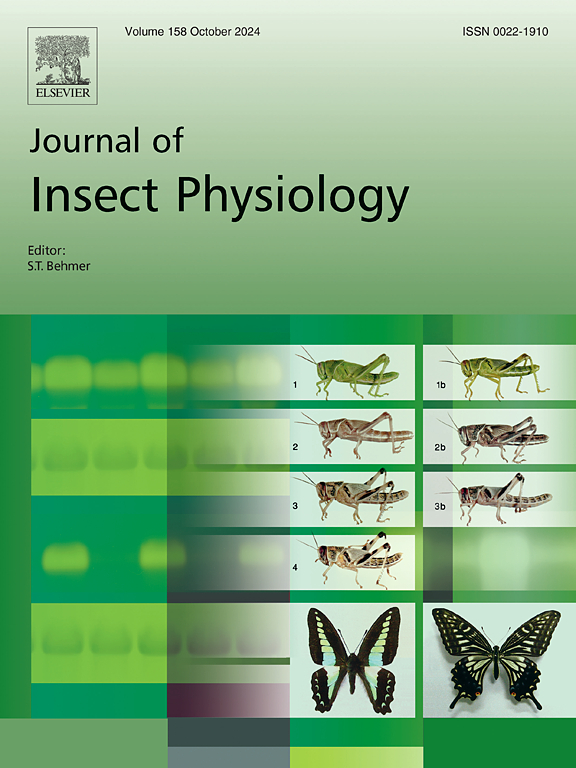Protein-rich trophallactic contents transferred from reproductives are crucial for termite soldier differentiation in Zootermopsis nevadensis
IF 2.3
2区 农林科学
Q1 ENTOMOLOGY
引用次数: 0
Abstract
Polyphenic castes exist for colony success in social animals. A primer pheromone has been suggested as a well-known regulator of caste development, but the basis of chemical communication has remained elusive over the last few decades. In termites, a long-standing hypothesis is that reproductive-secreted juvenile hormone (JH) plays a role as a primer pheromone involved in soldier differentiation. Here, we tested whether exogenous JH is necessary to induce differentiation of soldiers in the dampwood termite Zootermopsis nevadensis. The unique characteristic of this termite is that soldier-destined individuals can be monitored during their ontogeny under natural conditions. Furthermore, oral–anal trophallactic interactions with reproductives are required for soldier differentiation. First, knockdown of JH biosynthetic genes using RNA interference (RNAi) resulted in the reduction of soldier formation but did not affect the frequency of trophallactic interaction from reproductives to RNAi-treated individuals. Next, we compared the effect of parental replacement on soldier differentiation. Old-age reproductives had fewer stimulus effects on the differentiation of soldier-destined individuals compared to young-age reproductives. This difference in stimulus effects was derived from the protein levels within the digestive fluids of the king, but not those of the queen. Consequently, there is little or no possibility that JH itself plays a role as a primer pheromone. Alternatively, we propose that protein-rich nutrients in trophallactic fluids from reproductives are sufficient to induce high JH levels in larvae required for soldier differentiation.

从生殖体转移的富含蛋白质的营养物是内华达虫病白蚁士兵分化的关键。
在群居动物中,多缘种姓的存在是为了群体的成功。引物信息素被认为是种姓发展的一个众所周知的调节器,但在过去的几十年里,化学通讯的基础仍然是难以捉摸的。在白蚁中,一个长期存在的假设是生殖分泌的幼虫激素(JH)作为一种引物信息素参与了士兵分化。在这里,我们测试了外源JH是否需要诱导湿木白蚁(zotermopsis nevadensis)士兵分化。这种白蚁的独特之处在于,在自然条件下,可以在个体发育过程中对其进行监测。此外,与生殖动物的口-肛营养相互作用是士兵分化所必需的。首先,使用RNA干扰(RNAi)敲除JH生物合成基因导致士兵形成减少,但不影响从生殖个体到RNAi处理个体的营养相互作用频率。接下来,我们比较了亲代替代对士兵分化的影响。与年轻生殖相比,老年生殖对士兵个体分化的刺激作用较小。刺激效果的差异来自于国王消化液中的蛋白质水平,而不是王后的。因此,JH本身很少或根本不可能发挥引物信息素的作用。另外,我们认为来自生殖体的营养液中富含蛋白质的营养物质足以诱导士兵分化所需的幼虫体内高JH水平。
本文章由计算机程序翻译,如有差异,请以英文原文为准。
求助全文
约1分钟内获得全文
求助全文
来源期刊

Journal of insect physiology
生物-昆虫学
CiteScore
4.50
自引率
4.50%
发文量
77
审稿时长
57 days
期刊介绍:
All aspects of insect physiology are published in this journal which will also accept papers on the physiology of other arthropods, if the referees consider the work to be of general interest. The coverage includes endocrinology (in relation to moulting, reproduction and metabolism), pheromones, neurobiology (cellular, integrative and developmental), physiological pharmacology, nutrition (food selection, digestion and absorption), homeostasis, excretion, reproduction and behaviour. Papers covering functional genomics and molecular approaches to physiological problems will also be included. Communications on structure and applied entomology can be published if the subject matter has an explicit bearing on the physiology of arthropods. Review articles and novel method papers are also welcomed.
 求助内容:
求助内容: 应助结果提醒方式:
应助结果提醒方式:


